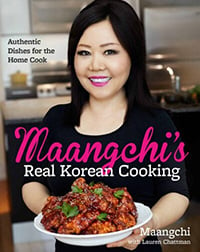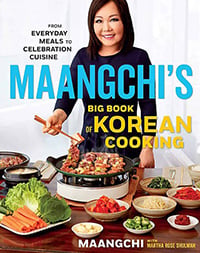You can buy a lot of Korean ingredients online these days, but a physical Korean grocery store is still the best place to buy ingredients and equipment for Korean cooking. They have the best selection and prices, and you can see what you are buying so you’re sure to get the best quality and exactly what you need.
But Korean grocery stores can be kind of confusing, especially if you can’t read Korean. Even if you speak Korean, there are plenty of tips and tricks for picking the best ingredients off the shelf. Choosing fruits and vegetables and reading packages is not always easy! So I made this series with the help of the Korean government’s Agro-Trade Center to show you how to shop in a Korean grocery store, step by step.
I had always wanted to make a series like this, but it was kind of hard for me to organize by myself. So I was very happy when the Agro-Trade Center New York offered to help me. The plan was to make a 20-minute video, but after looking at the footage I realized there was a ton of great information there that I couldn’t cut out. So it ended up as a series of four videos.
Special thanks to my readers Cora, Bridget, Lucy, Andrew C, Shawn, and Andrew Lee for coming along and helping me. I found them through my monthly letter, so be sure to sign up if you want to be the first to know about my next event.
And if you’re looking for a Korean grocery store in your area, be sure to check out the Korean grocery store directory on my website, where all the stores are submitted by my readers around the world. If your local store is not there, please add it!
Part One: Rice & Produce
I show you how to choose the right rice for Korean food, and walk you through the produce section so you can learn how to choose the best Korean vegetables for your cooking and kimchi-making.
More information about the ingredients in the video:
Short grain rice (Mepssal), Sweet rice (Chapssal), Perilla leaves (Kkaennip), King oyster mushrooms (Songi-beoseot), Soybean sprouts (Kongnamul), Mung bean sprouts (Sukjunamul), Green chili peppers (Cheong-gochu), Water dropwort (Minari), Red chili peppers (Hong-gochu), Taro (Toran), Asian chives (Buchu), Eggplant, Korean pear (Bae), Korean radish (Mu), Napa cabbage (Baechu), and Sweet potatoes (Goguma)
Recipes mentioned in the video:
Making rice, Seaweed rice rolls (Gimbap), Sweetened rice with fruits and nuts (Yaksik), Mushroom bulgogi, Mung bean pancake (Bindaetteok), Sweet, sour, and spicy mushrooms with water dropwort (Beoseot minari chomuchim), Taro soup (Toran-guk), Eggplant sidedish (Gaji-namul), Cubed radish kimchi (Kkakdugi), and Napa cabbage kimchi.
Part Two: Soy Sauces, Pastes, & Spices
These ingredients are essential to Korean cooking, but can be confusing to shop for. I show you how to buy them and we taste many brands to find the best!
More information about the ingredients in the video:
Soup soy sauce (Guk-ganjang), Regular soy sauce (Ganjang), Fish sauce (Aekjeot), Rice syrup (Salyeot), Corn syrup (Mulyeot), Black bean paste (JJajang, or Chunjang), Fermented Bean paste (Doenjang), Hot pepper paste (Gochujang), Korean hot pepper flakes (gochugaru) (Gochugaru), Korean spicy dipping sauce (Ssamjang), toasted sesame oil (Chamgireum), Toasted sesame seeds (Bokkeun-kkae), and Raw sesame seeds (Cham-kkae).
Recipes mentioned in the video:
Making soup soy sauce (Guk-ganjang), Yuja tea (Yujacha), Braised lotus roots (Yeon-geun-jorim), Noodles with blackbean sauce (Jjajangmyeon), Fermented soybean paste stew (Doenjang-jjigae), Hot pepper paste (Gochujang), Korean spicy dipping sauce (Ssamjang), and Toasted sesame seeds (Bokkeun-kkae).
Part Three: Noodles, Powders, Grains, Beans, & Seaweed
You can make many many delicious Korean dishes with these things, so we go over them one by one!
More information about the ingredients in the video:
Thin wheat noodles (Somyeon), Chewy buckwheat & wheat noodles (Naengmyeon), Starch noodles (Dangmyeon), Potato starch (Gamja-jeonbun), Mung bean jelly starch powder (Cheongpomuk-garu), Glutinous rice flour (Chapssalgaru), Barley malt powder (Yeotgireum-garu), Soybean powder (konggaru), Canned Mackerel Pike (Kkongchi tongjorim), Canned Mackerel (Godeungeo-tongjorim), Canned Whelks (Golbaengi-tongjorim), Korean curry powder (Ka-re-garu), Brown sweet rice (Hyeonmi-chapssal), Barley (Bori), Black sweet rice (Heukmi chapssal, Red beans (Pat), Soybeans (Mejukong), Dried mung beans (Mareun-nokdu), Dried, skinned & hulled mung beans (Geopi-nokdu), Dried seaweed sheets (Gim), Dried seaweed (Miyeok), Dried kelp (Dasima), Fernbrake (Gosari), and Bellflower roots (Doragi)
Recipes mentioned in the video:
Noodle soup (Guksu), Cold noodles in chilled broth (Mul-naengmyeon), Cold, spicy, chewy noodles (Bibim-naengmyeon), Sweet potato starch noodles stir fried with vegetables (Japchae), Hotteok filled with vegetables and noodles (Yachae hotteok), Crispy and crunchy fried chicken (Dakgangjeong), Mung bean jelly side dishes (Cheongpomuk-muchim), Hot pepper paste (Gochujang), Rice dessert drink (Sikhye), Rice cake (Injeolmi), Kimchi stew (Kimchi-jjigae), Spicy whelks with noodles (Golbaengi muchim), Korean-style curry rice (Kare-raiseu), Multigrain rice (Japgokbap), Red bean porridge (Dongji-patjuk), Fermented soybean paste (Doenjang), Mung bean sprouts (Sukju-namul), Mung bean pancakes (Bindaetteok), Seaweed rice rolls (Gimbap), Triangle gimbap (Samgak gimbap), Rice cake soup (Tteokguk), Seaweed soup (Miyeokguk), Bibimbap, and Spicy bellflower root side dish (Doragi-muchim).
Part Four: The frozen section, dried fish, fermented seafood, rice cakes, tofu & Korean kitchenware
This video gets a little chilly in the frozen and refrigerated sections! I also look at a few things in the kitchenware section like earthenware pots and crocks, and tabletop butane gas burners.
Ingredients mentioned in the video:
Artificial crab meat (Gemassal), Fish cakes (Eomuk), Dried anchovies (Mareun-myeolchi), Dried and shredded pollock (Bugeochae), Salted fermented shrimp (Saeujeot), Tube-shaped rice cake (Garaetteok), Sliced rice cake (Tteokgukyong-tteok), Yellow pickled radish (Danmuji), Tofu (Dubu), and Soft tofu (Sundubu)
Recipes mentioned:
Gimbap (Seaweed rice rolls), Fish cake soup (Eomukguk), Stir-fried dried anchovies (Myeolchi-bokkeum), Spicy stir-fried fish cakes (Eomuk-bokkeum), Fish cake soup (Eomukguk), Dried pollock soup (Bugeoguk), Kimchi, Hot and spicy rice cake (Tteokbokki), Rice cake soup (Tteokguk), Pan fried tofu with spicy sauce (Dububuchim-yangnyeomjang), Spicy soft tofu stew with kimchi and pork belly (Kimchi-sundubu-jjigae), Hot pepper paste (Gochujang), Grilled pork belly (Samgyeopsal-gui)
Kitchenware mentioned:
Earthenware bowl (Ttukbaegi), Earthenware crock (Onggi), and a Gas Burner.





Hi! I love you video for kimchi. I made nappa cabbage kimchi and radish kimchi. I used mason jars. I didnt sterilize the jars, but i did wash them with antibacterial dish soap. Will i be able to eat my kimchi and radish kimchi, or will it be contaminated?
I never sterilize my kimchi containers or jars and no problem! No need to sterilize them.
Maangchi, excellent series. Would you be able to tell me which restaurant did you go to after shopping. Please let me know. Best.
That restaurant was right in the grocery store. It’s a small cafeteria, but it has a large selection and all the food is delicious. When we ate there, the cook came out and told me she was one of my followers!
so informative…
thanks a bunch
This is very helpful. When I lived in Korea I never cooked a lot of Korean foods, but now that I am back in NYC I am interested in making more Korean dishes so I will use your tips for shopping ^^~
Hi,
I really love your recipes and I have been a fan of Korean cuisine for a long time, they are just so delicious!!
I have been having a problem finding Gyeoja-garu, and I was wondering if you can make it your self?
Thank you.
Hi Maangchi, thank you for the useful info in those videos. I have a question regarding the black bean paste: is “fermented black bean paste” the same as “black bean paste”? I saw both types at P.A.T yesterday, which one should I buy to make Jjajangmyeon?
This is a picture of the black bean paste that doesn’t say “fermented”. The korean characters look the same as the ones you show in the video.
See full size image
yes, it is roasted fermented black bean paste.
Thank you, Maangchi
Hi Maangchi! I’m Korean (moved to the states when I was 4) and even I have difficulty deciding what to choose. Usually trial and error. Every time I do find the one I like, it seems like they’re out or discontinued :-( Thank you for making these videos; it’s really informative!
This was so helpful maangchi, thank you for all the great information in this video. Helps me feel more confident stepping into a Korean grocery store! Can’t wait for part 2 :)
Thank you so much for your nice comment here!